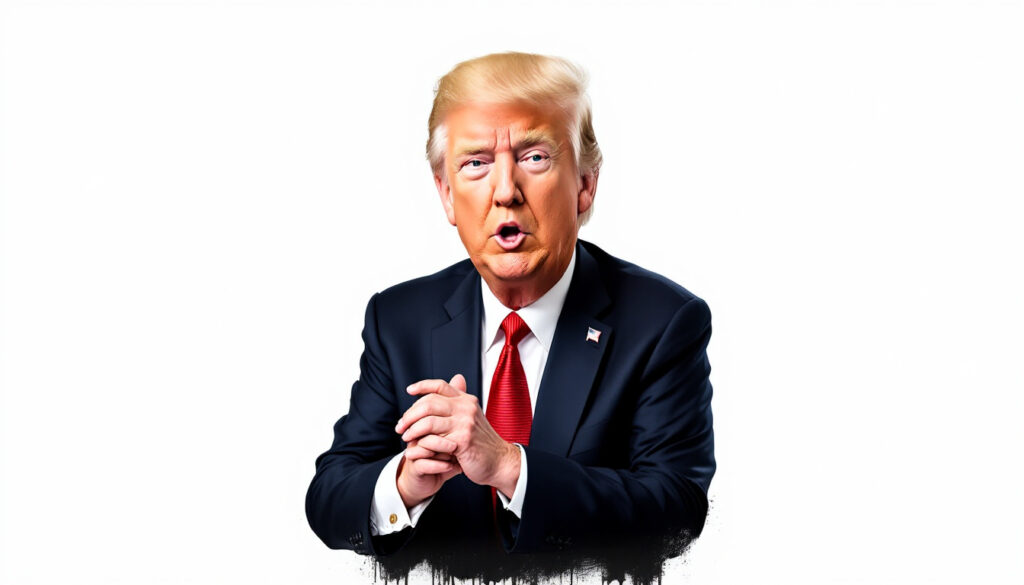How Will Trump's New Tariffs Affect Global Markets?
The implementation of President Donald Trump's new tariff regime is sending shockwaves through global financial markets. On April 5, 2025, a 10% tariff will be imposed on all imports from America's trading partners, with additional reciprocal tariff rates applying to 60 countries identified as having substantial nontariff barriers starting April 9. Markets have responded dramatically, with the S&P 500 falling by 4.5% and the tech-heavy Nasdaq 100 dropping 5% following the announcement.
This market reaction underscores the significant economic implications of these trade measures, which represent one of the most comprehensive tariff implementations in modern U.S. history. Analysts at major financial institutions predict these policies could reshape global trade patterns for years to come, with Trump's influence on global commodity markets becoming increasingly apparent.
Key Details of Trump's Tariff Plan
The tariff plan consists of several tiers of implementation, creating a complex web of trade barriers:
- 10% baseline tariff on all imports from trading partners effective April 5, 2025
- Additional reciprocal tariffs on 60 countries with nontariff barriers starting April 9, 2025
- Permanent 25% tariff rates on automobiles, steel, and aluminum
- Expected to generate at least $300 billion in annual tariff revenues, potentially up to $600 billion if negotiations stall
Economic experts note that while the administration has framed these tariffs as negotiating leverage, their immediate impact on global supply chains and inflation forecasts cannot be understated. The implementation timeline, particularly the rapid succession of the baseline and reciprocal tariffs, has caught many businesses unprepared for such sweeping changes.
What Are the Immediate Market Reactions to Trump's Tariffs?
The announcement of Trump's tariff policy has triggered significant volatility across multiple asset classes, demonstrating the far-reaching implications of these trade measures. Markets experienced some of the most dramatic single-day moves since the pandemic era, indicating serious concerns about global economic growth.
Equity Markets Response
The equity market reaction has been swift and decisive:
- S&P 500 declined by 4.5% in the session following the announcement
- Nasdaq 100 dropped 5%, with technology stocks particularly hard hit
- Dow Jones fell by 3.08% (1,302.61 points), marking its largest single-day decline in months
- VIX (volatility index) surged 26.78%, reflecting heightened market uncertainty
Sector-specific impacts reveal varying degrees of vulnerability, with technology, consumer discretionary, and industrial sectors experiencing the steepest declines. Companies with extensive global supply chains or significant export exposure face the greatest risks under the new tariff regime. The situation has been particularly challenging following Trump's China tariff threat and its global metal market impact.
Commodities Market Impact
Even traditional safe-haven assets haven't been immune:
- Gold prices fell 1.2% after hitting a fresh record high, contrary to its typical performance during market uncertainty
- Crude Oil WTI Futures dropped 7.31% on concerns about reduced global economic activity
- Silver Futures declined 7.22%, reflecting broader commodity market weakness
- Copper Futures decreased 3.86%, signaling concerns about industrial demand
Market analysts note that the commodities sell-off reflects fears of a synchronized global economic slowdown rather than typical risk-off behavior, suggesting deeper concerns about the tariffs' economic impact.
Currency and Bond Market Effects
Currency and fixed income markets reflected significant repositioning:
- Dollar Index fell 1.77%, contradicting the typical dollar strength during uncertainty
- U.S. 10-Year Treasury yield dropped 3.46% as investors sought safe-haven assets
- U.S. 5-Year Treasury yield decreased 4.96%, indicating expectations for prolonged economic challenges
This unusual dollar weakness suggests markets are reassessing the long-term implications of tariff-driven inflation on U.S. monetary policy and economic competitiveness.
How Will Tariffs Affect Inflation and Monetary Policy?
Major financial institutions have issued warnings about the inflationary impact of the new tariffs and their potential consequences for monetary policy. These concerns are particularly acute given the Federal Reserve's ongoing battle to contain inflation.
Inflation Concerns
The tariff implementation timeline points to significant inflationary pressures:
- JPMorgan predicts an inflation surge in Q2 and Q3 of 2025, potentially resembling pandemic-era price increases
- The 25% tariffs on autos, auto parts, steel, and aluminum expected to increase prices across multiple sectors
- Secondary effects include rising insurance premiums, repair costs, and used car prices
- Potential for sustained inflationary pressures similar to pandemic-era inflation but driven by policy rather than supply constraints
Economic analysts note that unlike transitory pandemic inflation, tariff-induced price increases could become embedded in the economy through wage-price spirals and changing inflation expectations. According to the BBC, economists have described the tariff situation as "worse than worst-case scenario" for global markets.
Federal Reserve Policy Implications
The Federal Reserve faces a particularly challenging policy environment:
- Morgan Stanley has removed its June rate cut prediction due to "tariff-induced" inflation
- The Fed may be unable to ease monetary policy if inflation remains above its 2% target
- Central bankers face a potential stagflation scenario with slowing growth and rising prices
- Potential conflict between managing inflation and supporting economic growth
This dilemma represents a significant reversal from the Fed's anticipated easing cycle, potentially keeping interest rates higher for longer than markets had previously expected. The relationship between US Fed rate decisions and gold market volatility is becoming increasingly complex in this environment.
What Are the Economic Consequences of Trump's Tariff Policy?
The tariffs are expected to have significant economic ramifications beyond immediate market volatility. These consequences will likely unfold over multiple quarters, affecting various stakeholders differently.
Consumer Impact
American consumers may face several challenges:
- Potential increase in prices of goods throughout 2025, reducing purchasing power
- Possible negative effects on consumer sentiment and real wages
- Risk of reduced consumer spending due to higher prices, potentially triggering a consumer-led slowdown by late 2025
- Disproportionate impact on lower-income households who spend a larger percentage of income on imported goods
Economic research suggests that in previous tariff implementations, approximately 85% of the tariff cost was passed through to consumers, with only 15% absorbed by foreign exporters.
Business and Supply Chain Effects
Corporate America faces significant operational challenges:
- Automotive industry particularly affected by 25% tariffs, potentially facing "double taxation" through tariffs and import fees
- Volkswagen planning to introduce an "import fee" on tariff-hit cars, setting a precedent other manufacturers may follow
- Disruption to global supply chains and potential for retaliatory measures from trading partners
- Increased compliance costs, especially for small and medium enterprises with limited resources to navigate complex tariff structures
Supply chain experts note that while some manufacturing may return to the U.S., the transition period will likely be marked by significant disruption and inefficiency.
How Should Investors Position Their Portfolios?
Market experts are offering guidance on investment strategies in response to the new tariff environment. Their recommendations reflect a shift toward defensive positioning and domestic exposure.
Defensive Positioning
Several defensive strategies have emerged:
- Gold expected to reach $4,000 by year-end according to Ed Yardeni, potentially sooner if tariffs persist
- Treasury bonds, despite lower yields, may offer portfolio protection during periods of equity volatility
- Certain sectors may benefit from tariff protection and domestic manufacturing focus
- Diversification across asset classes to manage increased volatility
Investment strategists note that traditional portfolio allocations may need recalibration in a higher-tariff environment, with greater emphasis on inflation protection. The record gold price surges driven by Trump's tariffs highlight this trend.
Potential Investment Opportunities
Not all sectors will suffer equally, with some potentially benefiting:
- Companies with primarily domestic supply chains stand to gain competitive advantages
- U.S. steel, aluminum, and automotive manufacturers may benefit from tariff protection
- Gold and other safe-haven assets likely to attract investment flows
- Sectors with less exposure to international trade tensions, such as utilities and telecommunications
- Small-cap stocks with primarily domestic revenue streams may outperform large multinationals
Analysts suggest investors should consider not just direct tariff impacts but second-order effects like changes in consumer behavior and supply chain restructuring. According to Reuters, many investors were stunned by the tariff announcements and are now preparing for a global growth shock.
What Historical Lessons Can Guide Investors Through Trade Wars?
Previous trade tensions offer valuable context for understanding potential market outcomes. The 2018-2019 trade conflict provides particularly relevant insights.
Lessons from Past Trade Conflicts
History offers important perspective:
- Market patterns similar to those seen during the 2018-2019 trade tensions, when the S&P 500 dropped approximately 6% in Q4 2018
- Initial sharp declines often followed by periods of adjustment as businesses adapt to new trade realities
- Sector-specific impacts varying based on exposure to international trade
- Bilateral negotiations typically lead to partial resolutions that stabilize markets
Market historian Alfonso Peccatiello notes that current market patterns share concerning similarities with 2008's volatility, suggesting heightened uncertainty about economic outcomes.
Long-term Market Considerations
Beyond immediate reactions, structural shifts may emerge:
- Market pattern not seen since 2008 appears to be back in play according to analysts
- Path of least resistance remains lower as markets weigh tariff impact
- Potential for negotiated resolutions that could stabilize markets, similar to the USMCA agreement in 2019
- Possibility of fundamental shifts in global supply chains and international trade relationships
Investment professionals emphasize that while short-term volatility is inevitable, historical precedent suggests markets eventually find equilibrium as policy uncertainty diminishes. Understanding global commodities market insights amid political shifts becomes crucial in this context.
FAQ: Trump Tariffs and Financial Markets
Will the new tariffs lead to a recession?
While analysts have not explicitly predicted a recession, there are concerns about a consumer-led slowdown later in 2025 if inflation remains elevated and real wages decline. The cumulative impact of higher prices, reduced business investment, and potential retaliatory measures could create significant headwinds for economic growth. However, the $300-600 billion in tariff revenue could potentially be deployed for fiscal stimulus that might offset some negative effects.
How long will market volatility persist following the tariff announcement?
Historical patterns suggest initial sharp declines followed by adjustment periods, but the duration of volatility will depend on potential retaliatory measures and policy developments. The 2018-2019 trade tensions saw approximately 6-8 months of elevated volatility before markets stabilized. Key metrics to watch include the VIX index staying above 20 and daily market moves exceeding 1%, which would indicate persistent uncertainty.
Which sectors are most vulnerable to the new tariff regime?
Industries with global supply chains, particularly automotive, technology, and consumer goods sectors, face the greatest exposure to tariff-related disruptions. Technology companies with significant manufacturing in China could see profit margins compressed by 10-15% according to industry analysts. Automotive manufacturers face particularly challenging circumstances with the 25% permanent tariffs, potentially forcing significant supply chain restructuring.
Are there any potential positive outcomes from the tariff policy?
The administration has expressed willingness to negotiate reciprocal reductions in tariffs, which could potentially lead to more favorable trade terms in the future. Some economists suggest that the threat of tariffs could accelerate the removal of non-tariff barriers that have long impeded U.S. exports. Additionally, certain domestic industries may experience growth and job creation as production shifts to avoid tariffs, though the net economic effect remains debated among experts.
How should individual investors adjust their strategies in response to tariffs?
Diversification, increased allocation to domestic-focused companies, and consideration of safe-haven assets like gold may help mitigate tariff-related market risks. Investment advisors recommend increasing exposure to companies with primarily domestic revenue streams, sectors with pricing power to pass on higher costs, and inflation-protected securities. For long-term investors, market volatility may present buying opportunities in fundamentally sound companies temporarily affected by tariff concerns.
Want to Capitalise on Major Market Shifts?
Don't miss investment opportunities created by global economic disruptions. Discover significant ASX mineral discoveries with real-time alerts powered by Discovery Alert's proprietary Discovery IQ model at https://discoveryalert.com.au/discoveries/, giving you the market-leading edge when trading commodities during volatile periods.




